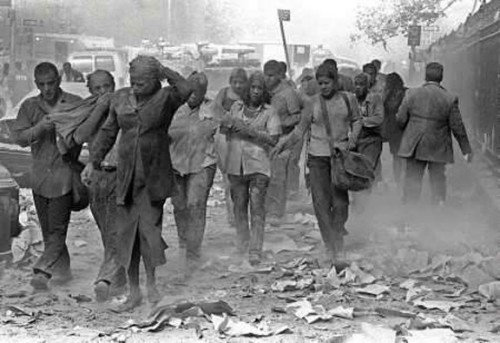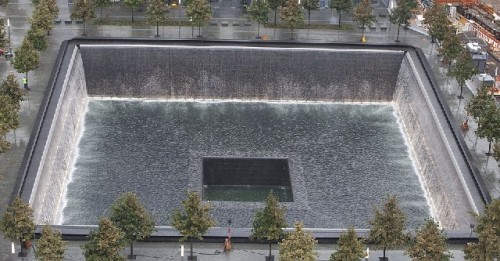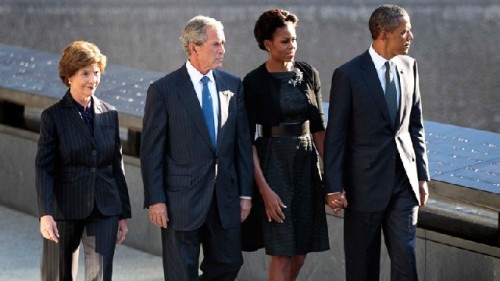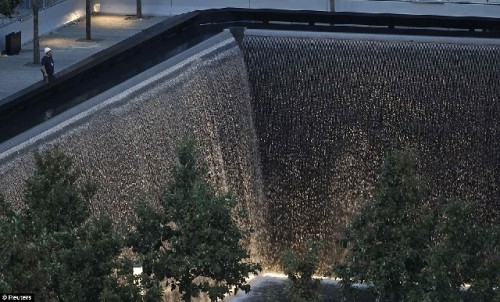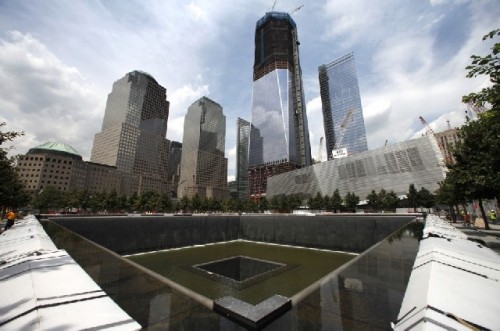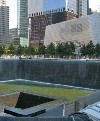9/11: Ten Years After
Remembering by Design
By: Mark Favermann - Sep 11, 2011
Today September 11, 2011 is the sad 10th Anniversary of the destruction of the Twin Towers, the former World Trade Center in Lower Manhattan. Long awaited, it was an often touching ceremony of remembrance of the heroes and victims (perhaps not always easy to differentiate) by their families, friends and politicians as well as by the entire American people.
Poetic words, symbolic gestures and beautiful music (by Yo-yo Ma, James Taylor and Paul Simon) along with the reading of the nearly 3,000 names of the individuals lost on that tragic evil day caused more than a few tears to be shed.
Visions of family members touching the names of loved ones, rubbing the lettering as a keepsake and placing flowers, flags and photos on the newly completed 9/11 Memorial at the site of the Two Towers was a sad series of real images of real people.
The poignant ceremony was funereal as well as somehow patriotic-- an event with a sense of family embracement, personal and universal. There was an eloquence to it that spoke to the event, to survival and remembrances of departed love ones.
This was the first public unveiling of the 9/11 Memorial. In 2008, I wrote a piece on among other things this topic Edifice Wrecks that analyzed the politically slow and painful process that was taking place at Ground Zero.
Things have changed since then, but the building schedule has not been speedy. The eventual aesthetic outcomes can still be architectural surprises or perhaps mediocre design solutions. However, the important outcome is the memory of the heroic first responders (EMTs, Fireman and Policeman), the construction workers and the lost loved ones.
At the time in March 2008, I wrote the following:
“Since I was a child in the 50’s, a visit to New Your City always got my heart pumping. Environmentally invigorating and just plain exciting, New York, New York felt different from any other place. And, it was. The wall of skyscrapers, the varying neighborhoods, the street grid, the variety of shops and stores, the noise both visual and aural and the wonderful mix of people added to the cacophony of ethnicity, urban grit, elegance and scale.
"My steps as well as those of countless others’ were always a little quicker when in New York. Here, energy flowed from the city to the visitor. New York still has great energy, but there seems to be something vitally missing in “The City” in the past few years.
"Of course, the confidence, the bravado, the great and often deserved swagger of American corporations and capital markets were devastated by the tragedy of 9/11.
This was so unexpected and so unfair. But instead of grieving properly and getting appropriate distance and therefore perspective, almost immediately major local and international architects, grieving relatives as well as civic and political leaders started pushing for a major design statement to reflect the tragic results of the loss of the Twin Towers.
"It appears that there has been just too much too early or too little real thought and too little civic and private commitment to get things done. The resulting mess of the 9/11 international site competition and the related memorial morass has led to creative dumbing down and urban stasis.
"New York State officials, prominently led by former Governor George Pataki, various pertinent and several rather impertinent state agencies, the Lower Manhattan Development Corporation (LMDC) and the Port Authority of New York and New Jersey along with designated developer Larry Silverstein and his corporate lapdog architect, Skidmore, Owens and Merrill (SOM) added little to the finishing of the often stranger than fiction Ground Zero Project bouillabaisse.
"This tragically messy soupcon of bureaucracy and procrastination never aided design quality or urban vision in terms of the project. Sprinkle in angry community stakeholders (the residents and businesses who are most affected by the project’s aspects), dissident architects and urban designers and New York’s untidy design review process, and you get what happened—plans not only gone awry but in some cases like the winning design schemes literally gone asunder.
"Like an urban design ghost, Daniel Libeskind’s 2002 competition-winning site plan has virtually vanished being superseded by SOM’s developer-driven Freedom Tower interpretation and its adjacent buildings. Couple this strategic architectural conflict of the mediocre over the potentially poetic with the disastrous result of the competition-winning Michael Arad memorial and memorial plaza.
"First, Arad was forced into a shotgun marriage of convenience with eminent landscape architect Peter Walker. This has led to another war of wills and egos in regard to the final interpretation of the site. Arad’s memorial staggers on the edge of collapse. The last cost estimates are around one billion dollars. Mayor Bloomberg’s folks have demanded the original simply elegant but now greatly enhanced design to be scaled back. Designer Arad has had to fight the LMDC all along the way as well.
"Since he first won the memorial competition, Arad has had to defend his design from attacks by the deeply entrenched cronyism and slip-shod management of a powerful community development corporation. To say that Arad’s relationships with the various architects and landscape architects have been rancorous would be an understatement.
"Both sides seem to be involved in personal attacks on each other. There is great pressure on the LMDC to complete the project by 2009 to give former Governor Pataki a legacy. Arad has been accused of tantrums and threats.
"Added to this is the fact that many members of the various victims groups do not like his design. These include several victims groups, and they have been empowered from early on in this process. This is an awkward situation: a national even international memorial that has given individual mourners some veto power. Against Arad, claims of him causing great delays and being uncooperative have been the main complaints by the other players. And, so it goes.”
Now nearly two year’s after the 2009 date, a sleeker, less costly memorial is completed. On many levels, it seems to be quite good. A later article will review the design features of this structured landscape. In the intervening years, Michael Arad has professionally mellowed. It is now said that he has matured. His ability to cooperate and collaborate has grown. Peter Walker’s name is now associated with Michael Arad’s as the two designers of the 9/11 Memorial.
The other pieces to the Ground Zero site plan are now under construction. SOM's Freedom Tower (strangely now being referred to as One World Trade by the developer) has risen many stories. Other nearby buildings are going up as well. No matter what the architectural outcomes of this place, the legacy of this entire project will not be found in the quality of the buildings, the present and former politicians’ influence or the developer’s softened vision.
The remembered terrible image of the destruction of the two large awkward buildings is a painful nightmare architecture. Like today’s ceremony, the real legacy will not be the physical structures, but the remembrance of those who sadly perished there.
Note to readers: Due to the fact that the 9/11 Memorial is in the middle of a massive construction site, the 9/11 Memorial Foundation is limiting the visits by the public. Tickets must be obtained in advance at particular times like a blockbuster museum exhibition. Tickets and schedule can be gotten from the 9/11 Memorial website:www.911memorial.org.


